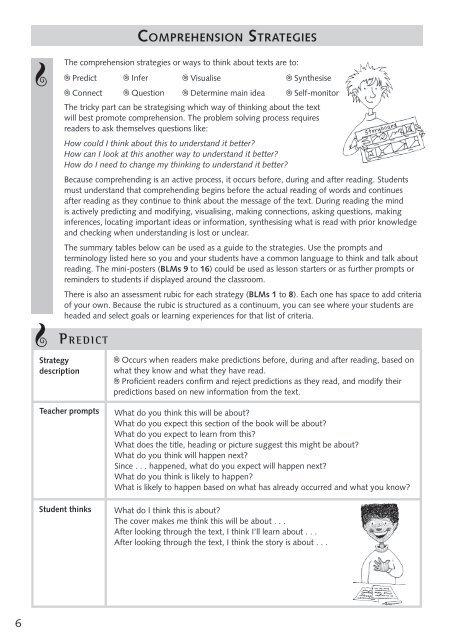All You Need To Teach Comprehension 10+
Create successful ePaper yourself
Turn your PDF publications into a flip-book with our unique Google optimized e-Paper software.
P r e d i ct<br />
<strong>Comprehension</strong> Strategies<br />
The comprehension strategies or ways to think about texts are to:<br />
@ Predict<br />
@ Connect<br />
@ Infer<br />
@ Question<br />
@ Visualise<br />
@ Determine main idea<br />
The tricky part can be strategising which way of thinking about the text<br />
will best promote comprehension. The problem solving process requires<br />
readers to ask themselves questions like:<br />
How could I think about this to understand it better?<br />
How can I look at this another way to understand it better?<br />
How do I need to change my thinking to understand it better?<br />
@ Synthesise<br />
@ Self-monitor<br />
Because comprehending is an active process, it occurs before, during and after reading. Students<br />
must understand that comprehending begins before the actual reading of words and continues<br />
after reading as they continue to think about the message of the text. During reading the mind<br />
is actively predicting and modifying, visualising, making connections, asking questions, making<br />
inferences, locating important ideas or information, synthesising what is read with prior knowledge<br />
and checking when understanding is lost or unclear.<br />
The summary tables below can be used as a guide to the strategies. Use the prompts and<br />
terminology listed here so you and your students have a common language to think and talk about<br />
reading. The mini-posters (BLMs 9 to 16) could be used as lesson starters or as further prompts or<br />
reminders to students if displayed around the classroom.<br />
There is also an assessment rubic for each strategy (BLMs 1 to 8). Each one has space to add criteria<br />
of your own. Because the rubic is structured as a continuum, you can see where your students are<br />
headed and select goals or learning experiences for that list of criteria.<br />
Strategy<br />
description<br />
<strong>Teach</strong>er prompts<br />
Student thinks<br />
@ Occurs when readers make predictions before, during and after reading, based on<br />
what they know and what they have read.<br />
@ Proficient readers confirm and reject predictions as they read, and modify their<br />
predictions based on new information from the text.<br />
What do you think this will be about?<br />
What do you expect this section of the book will be about?<br />
What do you expect to learn from this?<br />
What does the title, heading or picture suggest this might be about?<br />
What do you think will happen next?<br />
Since . . . happened, what do you expect will happen next?<br />
What do you think is likely to happen?<br />
What is likely to happen based on what has already occurred and what you know?<br />
What do I think this is about?<br />
The cover makes me think this will be about . . .<br />
After looking through the text, I think I’ll learn about . . .<br />
After looking through the text, I think the story is about . . .<br />
6


















